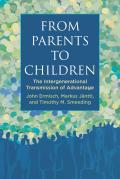Main navigation
 Yesterday, we looked at some of the lessons from Great Britain's recent push to expand access to preschool education. Today, we examine the preschool experience in France, where almost all children are enrolled in preschool at the age of three. First established in 1882, preschool -- or ecole maternelle -- has a long history in France, but the universal access that currently exists largely stems from reforms adopted in the 1960s and 1970s. During this period, according to Christelle Dumas and Arnaud LeFranc, enrollment rates for three-year-olds increased from around 35 percent to more than 90 percent. Preschool conditions in France are similar to primary education -- instructors generally receive the same level of training as primary school teachers, and children receive a substantial amount of instruction (typically six hours per day, four days a week, and thirty-six weeks per year).
Yesterday, we looked at some of the lessons from Great Britain's recent push to expand access to preschool education. Today, we examine the preschool experience in France, where almost all children are enrolled in preschool at the age of three. First established in 1882, preschool -- or ecole maternelle -- has a long history in France, but the universal access that currently exists largely stems from reforms adopted in the 1960s and 1970s. During this period, according to Christelle Dumas and Arnaud LeFranc, enrollment rates for three-year-olds increased from around 35 percent to more than 90 percent. Preschool conditions in France are similar to primary education -- instructors generally receive the same level of training as primary school teachers, and children receive a substantial amount of instruction (typically six hours per day, four days a week, and thirty-six weeks per year).
In their chapter in From Parents to Children: The Intergenerational Transmission of Advantage, Dumas and LeFranc exploited this rapid rise in enrollment to assess the impact of preschool education on students' educational and labor market outcomes. Their study is important because there are relatively few assessments of universal access preschool programs; most research, at least in the United States, has focused on targeted experiments such as the Perry program. Dumas and LeFranc offer a generally positive assessment: they conclude that one additional year of French preschool reduced the probability of repeating first grade, and that attending preschool for two and three years, rather than one year, increased participants’ monthly wages by 3.2 percent and 3.6 percent respectively when they entered the labor market. Here is their summary of their main findings:
We find evidence that preschool has significant and lasting positive effects and helps children succeed in school and secure higher wages in the labor market. The effects on school performance are observed at different ages and through a variety of outcomes (number of repetitions, test scores, diplomas). Identification of long-lasting effects contradicts the results of Magnuson and her colleagues (2007) for the United States. More precisely, preschool does not provide a one-shot advantage but, rather, makes children more likely to succeed at each step of their schooling career and in the labor market. This suggests that this early intervention manages to affect more than just the cognitive level of the children. Unfortunately, the data do not allow us to identify what changes for the children who have attended preschool. Are they more able to concentrate? Have they developed social skills? Do they assimilate rules more easily? The answer is probably a mix of these mechanisms, but is a matter for future research to explore.
There is another important caveat: The effects of preschool are not the same across the income spectrum. Preschool in France tends to mostly benefit children from middle and lower classes, while children from upper classes "gain hardly anything." Dumas and LeFranc conclude:
The children of higher-grade professionals systematically get lower returns to preschool than the reference category—that is, the children of non-manual workers, lower-grade professionals, and artisans. In fact, the global effect of preschool for the children of higher-grade professionals is not significantly different from zero. The exception is for test scores, where all groups benefit from preschool in the same way. Manual workers’ and farmers’ children gain as much as the reference category from preschool: in most of the specifications, the coefficient in the second line is not significantly different from zero. As a consequence, preschool is an intervention that tends to close the gap between children from lower and upper social groups and therefore plays a role in reducing intergenerational transmission of inequalities.
Read more about the study in chapter 7 of From Parents to Children, including details on how Dumas and LeFranc dealt with the possible endogeneity of preschool enrollment vis-a-vis other family determinants of child achievement.





